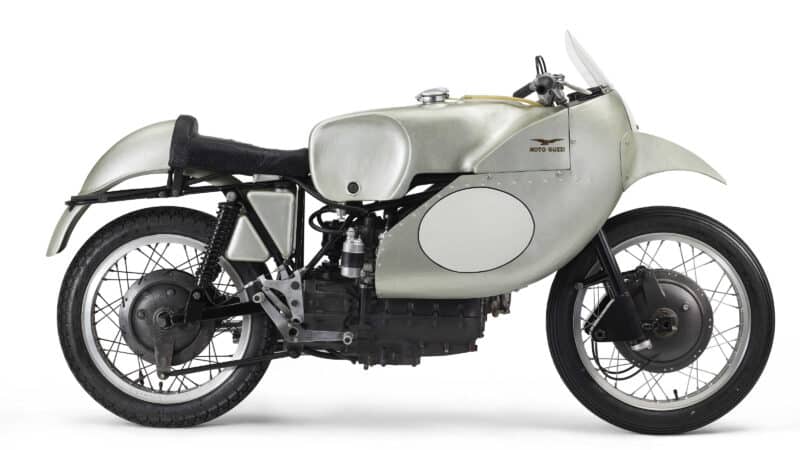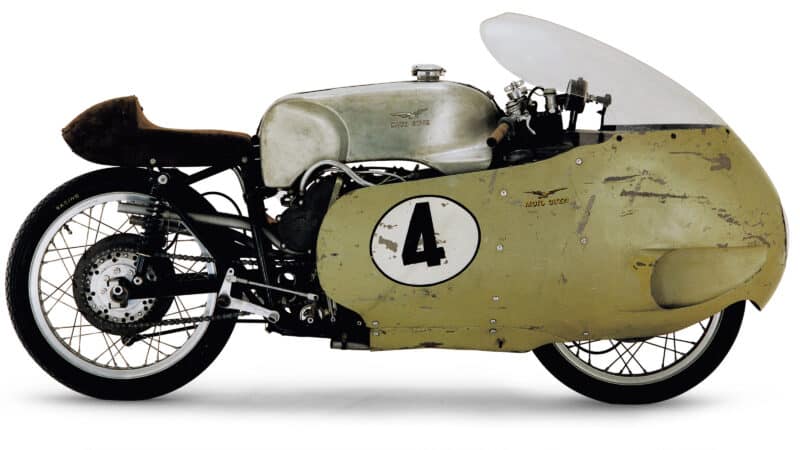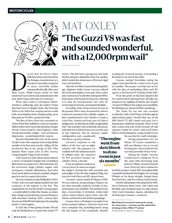When Geoff Duke won the 1955 Italian Grand Prix at Italy’s Monza, his race speed was 113.7mph, aboard a 65-horsepower, 150mph dust-binned Gilera 500cc four.
Today’s fastest MotoGP circuit is Australia’s Phillip Island, where last year’s winner Marc Márquez averaged 112.7mph, aboard a 300-horsepower, 225mph 1000c Ducati Desmosedici.
Very soon all the manufacturers were fitting dustbins to their MotoGP bikes. The technology reached its peak with Carcano’s glorious Moto Guzzi V8 500, which wore a fabulously expensive fairing fabricated in magnesium.
The V8’s fairing always raced with its fairing painted a muddy green. In fact this wasn’t paint, the colour came from chemical treatment to prevent the magnesium corroding.
Very soon there were all kinds of people complaining about dustbin fairings.
By the way, the V8’s eight 62.5cc cylinders disprove the common belief that the Japanese manufacturers were the first to miniaturise cylinder size to increase revs and therefore power, a decade before Honda’s 250cc six.
Very soon there were all kinds of people complaining about dustbin fairings.
First, there were safety concerns, because these fully enveloping fairings made the bikes very difficult to handle, especially in sidewinds. Then there were the manufacturers that disagreed with this new avenue of development. These included Norton, which quit MotoGP at the end of 1954, its 500cc single still equipped with nothing more than a tiny flyscreen. And finally the governing body, the FIM, was concerned that hiding the riders from view was bad for spectators.

Guzzi’s very technically advanced longitudinal four-cylinder 500cc MotoGP bike of 1953 – its fairing was similar to the so-called dolphins that replaced the dustbins
Moto Guzzi
Therefore dustbins were banned at the FIM congress of October 1954, when Count Giovanni ‘Johnny’ Lurani Cernuschi, president of the FIM’s sporting commission, came up with this formula, which has remained largely unchanged since.
“Nothing should exceed the vertical plane running through the axis of the front or rear wheel; the whole of the front wheel should be visible, the rider should be completely visible from every angle, except the front.”
When the dustbins were thrown out, they were immediately replaced by so-called dolphin fairings, basically similar to today’s bodywork.
In fact Guzzi’s Carcano had already started down this road with his beautiful 1953 longitudinal four-cylinder 500 – four cylinders in tandem, not side by side – which had a more minimal fairing, with front fender. This machine was very technically advanced, with shaft drive, linked brakes and an early type of fuel injection.
Since then MotoGP’s aero rules have been tweaked as motorcycles evolved. For example, as front geometry steepened – in search of quicker steering – fairings were allowed to protrude beyond the front-wheel axle to increase stability.
The 2027 aero rules should decrease aerodynamic downforce by shrinking the size and shape of the upper front fairing, where most downforce is generated. The maximum width of the upper fairing reduces by 50mm to 550mm, the fairing nose is moved back by 50mm, the maximum height at the rear of the bike is reduced by 100mm to 1150mm and the rearward taper of the front fairing aero appendices are narrowed.
The most important measurements here are the upper width and the fairing nose, because moving the nose back should significantly reduce the load over the front tyre. These reductions should also reduce the wake effect, though we won’t know by how much until the new bikes – which will also feature smaller 850cc engines and no ride-height devices – are actually racing in 2027.




